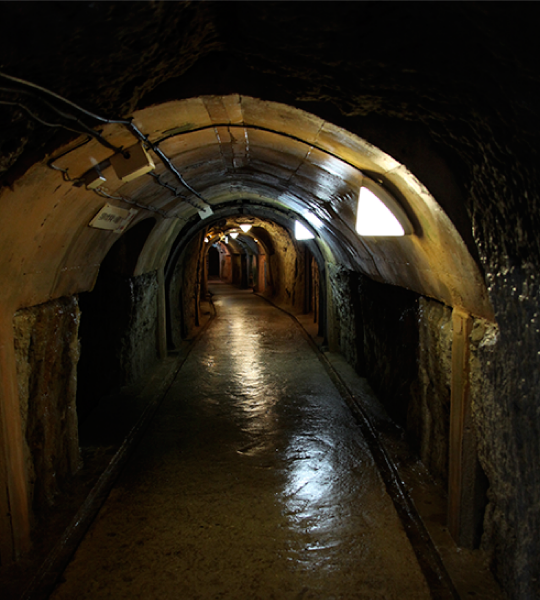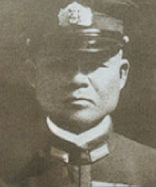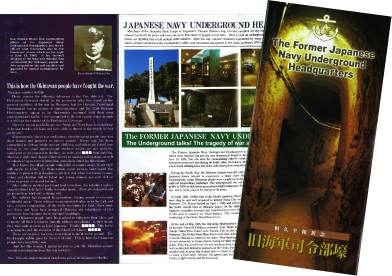History and outline

This tunnel complex was dug in 1944 as an underground headquarters by 3000 men of the Yamane Division of the Japanese Navy Engineering Corps. It is located in a hill 74 meters above sea level that overlooks the airport and the port among other surroundings.
Dug 20 meters deep and 450 meters in length in a semi-circular shape, this underground air-raid shelter was solidly built with concrete and pit props to endure the violent bombardments of the US armed forces and to allow long-drawn-out fighting. It accommodated 4000 soldiers.
After the war, the site was left unaltered for a while. However, after a number of recoveries of soldiers’ remains, 300 meters of the headquarters centered on the commanding officer’s room were restored and opened to the public in March 1970 by the Okinawa Tourism Board, today’s Okinawa Convention & Visitors Bureau.
Rough chronological table
of events
| August 1944: | Navy Iwao Corps (base flying corps) and Yamane Corps (construction corps) advance in Okinawa. Start of the construction of the Japanese Navy Underground Headquarters. |
|---|---|
| August 9th: | Transfer from Amami Islands to Oroku Airbase of the Okinawa area headquarters (4th marine convoy corps headquarters). |
| (1945) January 20th: |
Ota Minoru takes up his post of commanding officer of the Navy Okinawa area corps. |
| January 25th: | The Okinawa area corps and the 4th marine convoy corps headquarters are separated. The Okinawa area corps is devoted to defensive preparations. |
| April 1st: | Beginning of the landing of the US military on the coast of the main island of Okinawa (in Chatan and Yomitan, in the central area of the main island). |
| Mid May: | Following the deterioration of the battle of Shuri, 2500 members of the Navy corps are dispatched under the Army command. |
| May 27th: | The 32nd Army headquarters starts its evacuation to Mabuni. |
| May 31st: | The US Army takes possession of Shuri. |
| June 4th: | The U.S. 6th Marine Division strikes the Oroku area. |
| June 6th: | The U.S. army captures Oroku airfield. Commanding officer Ota Minoru sends the telegram “This is how the Okinawa people have fought the war”. |
| June 11th: | With the 14-day general offensive of the U.S. army on the Oroku area, the Japanese Navy Okinawa area corps is almost annihilated. |
| June 13th: | Commanding officer of the Navy Okinawa area corps Ota Minoru and 6 of his staff officers commit suicide in the headquarters. |
| June 23th: | General Ushijima Mitsuru commits suicide. |
| Aug. 15th: | Unconditional surrender of Japan. |
| Aug. 27th-28th: | The U.S. army enters the tunnel complex to verify the death of the commanding officer and his men and to search for surviving Japanese soldiers. The death of Ota Minoru and his staff officers is confirmed. |
| 1952: | The government starts recovering the remains of soldiers. |
| March 1970: | The Okinawa Tourism Board (present Okinawa Convention & Visitors Bureau) restores and opens the headquarters. |
Account of Rear Admiral
Ota Minoru

Having made a name for himself as the Navy landing force authority, Rear Admiral Ota took the post of commanding officer of the Navy Japanese forces for the Okinawa area on January 20, 1945, 2 months before the invasion of the US armed forces. Struck by the fierce attack of the US armed forces, he committed suicide with 6 staff officers on the night of June 13, 1945
From this headquarters, Rear Admiral Ota addressed a famously composed telegraph to the Navy Vice Admiral on the real conditions of the last stage of the battle and the state of affairs concerning the cooperation of Okinawan people. It ends with these words: “This is how the Okinawan people have fought the war, and for this reason, I ask you to give the Okinawan people special consideration from this day forward.”
The telegraph of
commanding officer
Ota Minoru
昭和20年6月6日 20時16分
次の電文を海軍次官にお知らせ下さるよう取り計らって下さい。
沖縄県民の実情に関しては、県知事より報告されるべきですが、県にはすでに通信する力はなく、32軍(沖縄守備軍)司令部もまた通信する力がないと認められますので、私は、県知事に頼まれた訳ではありませんが、現状をそのまま見過ごすことができないので、代わって緊急にお知らせいたします。
沖縄に敵の攻撃が始って以来、陸海軍とも防衛のための戦闘に専念し、県民に関しては、ほとんどかえりみる余裕もありませんでした。しかし、私の知っている範囲では、県民は青年も壮年も全部を防衛のためかりだされ、残った老人、子供、女性のみが、相次ぐ砲爆撃で家や財産を焼かれ、わずかに体一つで、軍の作戦の支障にならない場所で小さな防空壕に避難したり、砲爆撃の下でさまよい、雨風にさらされる貧しい生活に甘んじてきました。
しかも、若い女性は進んで軍に身をささげ、看護婦、炊飯婦はもとより、防弾運びや切り込み隊への参加を申し出る者さえもいます。敵がやってくれば、老人や子供は殺され、女性は後方に運び去られて暴行されてしまうからと、親子が行き別れになるのを覚悟で、娘を軍に預ける親もいます。
看護婦にいたっては、軍の移動に際し、衛生兵がすでに出発してしまい、身寄りのない重傷者を助けて共にさまよい歩いています。このような行動は一時の感情にかられてのこととは思えません。さらに、軍において作戦の大きな変更があって、遠く離れた住民地区を指定された時、輸送力のない者は、夜中に自給自足で雨の中を黙々と移動しています。
これをまとめると、陸海軍が沖縄にやってきて以来、県民は最初から最後まで勤労奉仕や物資の節約をしいられ、ご奉公をするのだという一念を胸に抱きながら、ついに(不明)報われることもなく、この戦闘の最期を迎えてしまいました。
沖縄の実績は言葉では形容のしようもありません。一本の木、一本の草さえすべてが焼けてしまい、食べ物も6月一杯を支えるだけということです。
沖縄県民はこのように戦いました。県民に対して後世特別のご配慮をして下さいますように。(この電文は原文を現代文に直したものです。)
English translation
This is how the Okinawan people have fought the war
Sent at 20:00 on 16 June 1945
Please convey the following telegram to the Vice-Admiral
While the Governor should be the person to relay this report on the present condition of Okinawan inhabitants, he has no available means of communication, and the 32nd Division Headquarters appears to be thoroughly occupied with their own correspondences. However, due to the critical situation we are in, I feel compelled to make this urgent report, although it is without the Governor's consent.
Since the enemy attack began, our Army and Navy have been fighting defensive battles and have not been able to attend to the people of this prefecture. Consequently, due to our negligence, these innocent people have lost their homes and property to enemy assault. Every man has been conscripted to partake in the defense while women, children and elders are forced into hiding in small underground shelters which are not tactically important or are exposed to shelling, air raids and the harsh elements of nature. Moreover, girls have devoted themselves to nursing and cooking as well as volunteering to carry ammunition and join in attacking the enemy.
This leaves the village people vulnerable to enemy attack where they will surely be killed. In desperation, some parents have asked the military to protect their daughters for fear that when the enemy comes, elders and children will be killed and young women and girls will be taken to private areas and harmed.
Nurses, with wounded soldiers, wander, move and leave them behind. It cannot be believed that such behavior is due to temporary feelings.
The military has changed its operations, ordering people to move from the residential areas, however those without means of transportation trudge along by foot in the dark and rain all the while looking for food to stay alive.
Ever since our Army and Navy occupied Okinawa, the inhabitants of this Prefecture have been forced into military service and hard labor while sacrificing everything they own as well as the lives of their loved ones. They have served with loyalty.
Now we are nearing the end of this battle, but they will go unrecognized, unrewarded. Seeing this I feel deeply depressed and I am at loss of words for them. Every tree, every plant life is gone. Even the weeds are burnt. By the end of June, there will be no food. This is how the Okinawan people have fought the war, and for this reason, I ask you to give the Okinawan people special consideration from this day forward.
Number of deaths in the
Battle of Okinawa
(according to Okinawa Prefecture’s documents)
Total deaths: 200,656 people
Japanese side:
From other prefectures (soldiers and civilian employees): 65,908 people
From Okinawa (participants in the battle): 56,861 people
From Okinawa (soldiers and civilian employees): 28,228 people
Non-fighting Okinawan civilians (estimation): 37,139 people
American side:
12,520 people

